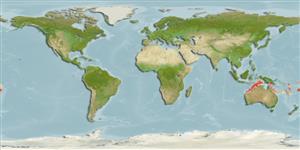Environment: milieu / climate zone / depth range / distribution range
Οικολογία
Θαλασσινό(ά) βενθικό(ς); εύρος βάθους 73 - 210 m (Ref. 5222). Tropical; 1°N - 23°S, 115°E - 177°W (Ref. 5222)
Eastern Indian Ocean: Western Australia. Eastern Central Pacific: American Samoa and the Phoenix Islands.
Μέγεθος / Βάρος / Age
Maturity: Lm ? range ? - ? cm
Max length : 71.0 cm TL αρσενικό/απροσδιόριστο; (Ref. 125599); μεγ. δημοσιευμένο βάρος: 4.5 kg (Ref. 125599)
Ραχιαίες άκανθες (συνολικά): 11; Μαλακές ραχιαίες ακτίνες (συνολικά): 16-17; Εδρικές άκανθες 3; Μαλακές εδρικές ακτίνες: 8. Preopercle angle with 2 - 4 distinctly enlarged serrae; upper edge of the operculum straight or nearly so; nostrils small, subequal; maxilla extends to below rear half of the eye. Color is pale brownish gray with yellow or golden brown spots on the head, nape and chest. A row of dark yellowish brown spots along the margin of the soft dorsal and anal fins and the rear edge of the caudal fin. Pelvic fins with yellowish brown and whitish streaks and a few yellowish brown spots distally. Further characterized by body depth contained 2.7-3.4 times in SL; head length 2.4-2.7 times in SL; flat to convex interorbital area; 2-4 distinctly enlarged serrae at preoopercle angle; upper edge of operculum nearly straight or straight; small anterior and posterior nostril, subequal; maxilla extends to below rear half of eye; 2 rows of teeth on midlateral part of lower jaw (Ref. 89707).
Nothing has been published on the biology of this rare species. The apparent rarity of this species is probably a result of its deep-water habitat and the fact that it was only recently described as a new species.
Life cycle and mating behavior
Γεννητική Ωρίμανση | Αναπαραγωγή | Γεννοβολία | Αβγά | Γονιμότητα | Προνύμφες
Heemstra, P.C. and J.E. Randall, 1993. FAO Species Catalogue. Vol. 16. Groupers of the world (family Serranidae, subfamily Epinephelinae). An annotated and illustrated catalogue of the grouper, rockcod, hind, coral grouper and lyretail species known to date. Rome: FAO. FAO Fish. Synop. 125(16):382 p. (Ref. 5222)
IUCN Red List Status (Ref. 130435)
Threat to humans
Harmless
Human uses
αλιεία: χωρίς ενδιαφέρον
Περισσότερες πληροφορίες
Κοινά ονόματαΣυνώνυμαΜεταβολισμόςΘηρευτέςΟικοτοξικολογίαΑναπαραγωγήΓεννητική ΩρίμανσηΓεννοβολίαΣυναθροίσεις γεννοβολίαςΓονιμότηταΑβγάEgg development
ΑναφορέςΥδατοκαλλιέργειεςΠροφίλ υδατοκαλλιέργειαςΣτελέχοιΓενετικήElectrophoresesΚληρονομικότηταΑσθένειεςΜεταποίησηNutrientsMass conversion
ΣυνεργάτεςΦωτογραφίεςStamps, Coins Misc.ΉχοιΣιγκουατέραΤαχύτηταΚολυμβητικός ΤύποςΕπιφάνεια βραγχίωνOtolithsΕγκέφαλοιΌραση
Εργαλεία
Special reports
Download XML
Διαδικτυακές πηγές
Estimates based on models
Preferred temperature (Ref.
123201): 21.4 - 25.3, mean 23.3 °C (based on 34 cells).
Phylogenetic diversity index (Ref.
82804): PD
50 = 0.5000 [Uniqueness, from 0.5 = low to 2.0 = high].
Bayesian length-weight: a=0.00955 (0.00556 - 0.01641), b=3.00 (2.86 - 3.14), in cm total length, based on LWR estimates for this species & Genus-body shape (Ref.
93245).
Τροφικό Επίπεδο (Ref.
69278): 3.9 ±0.5 se; based on size and trophs of closest relatives
Ελαστικότητα (Ref.
120179): Χαμηλό, ελάχιστος χρόνος για διπλασιασμό πληθυσμού 4,5 - 14 έτη (Preliminary K or Fecundity.).
Fishing Vulnerability (Ref.
59153): Moderate to high vulnerability (48 of 100).
Nutrients (Ref.
124155): Calcium = 122 [54, 276] mg/100g; Iron = 1.04 [0.50, 2.42] mg/100g; Protein = 17.6 [15.9, 19.1] %; Omega3 = 0.253 [0.133, 0.476] g/100g; Selenium = 58.1 [28.2, 130.8] μg/100g; VitaminA = 68.7 [16.7, 285.5] μg/100g; Zinc = 1.46 [0.92, 2.38] mg/100g (wet weight);
